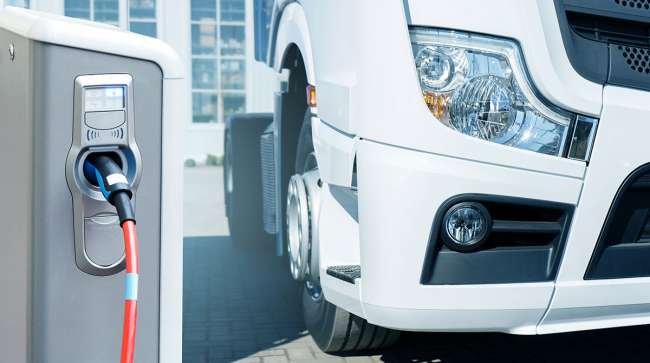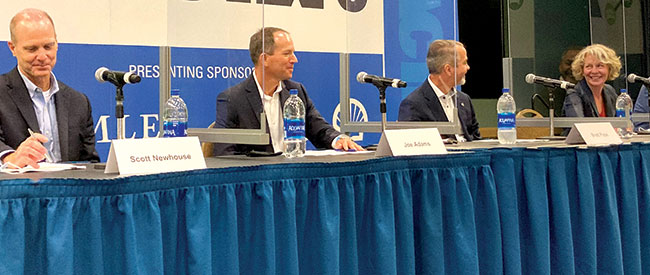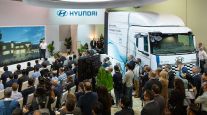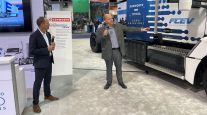Senior Reporter
OEMs Outline Vision for EV Transition Phases, Targets for Next 20 Years

[Stay on top of transportation news: Get TTNews in your inbox.]
LONG BEACH, Calif.— Truck maker executives said they are preparing for when broader support for zero-emission vehicles will come and sales will climb. Production cycles will speed up, customers’ options will narrow and, perhaps, buy-side rules for carriers will come into effect to spur sales.
For now, financial incentives, sell-side rules, especially in California, aimed at truck makers and the promise of corporate sustainability goals founded on zero emissions and generally targeted for 2040 are supporting the medium- and heavy-duty truck electrification market.
At some point, corporate requirements will drive adoption of electric vehicles “perhaps more than even the regulations,” said Brett Pope, director of electric vehicles for Volvo Trucks North America.
Take a walk around the #VNRElectric. #ACTexpo pic.twitter.com/ekX1oGsfL4 — Volvo Trucks North America (@VolvoTrucksNA) September 1, 2021
Pope was among the speakers in The Future of Ultra Clean Heavy Duty session at the Advanced Clean Transportation Expo. on Aug. 30-Sept. 2.
“One of the observations I find really fascinating is when you are out talking with carriers, you very clearly see the push from [our] customers’ customers,” Pope said.
Major U.S. corporations such as FedEx Corp., Amazon.com Inc. and Walmart Inc. are striving to meet zero-emission sustainability goals, including electrifying vehicles, in the next 20 years or so.
At Kenworth Truck Co., a brand of Paccar Inc., discussions about how fast the market is going to mature with regulations happen regularly, Chief Engineer Joe Adams said.
Kenworth is at ACT Expo displaying a zero-emission truck lineup: the Battery Electric Kenworth K270E, Natural Gas new medium duty Kenworth T280 and Hydrogen Fuel Cell Kenworth T680.#Kenworth #ZeroEmissions #BatteryElectric #T680 #K270E #ACTExpo pic.twitter.com/qkGTJ4BzVY — Kenworth Truck Co. (@KenworthTruckCo) August 31, 2021
“I think it is going to take a balance of both sell- and buy-side [regulation] if this is how we are going to move forward as an industry — not just putting regulations on the OEMs to build the zero-emission vehicles,” he said. “It also is going to take, I believe, some regulations for our customers. That will help push [the market] more mainstream.”
Kary Schaefer, general manager of product marketing and strategy for Daimler Trucks North America, said in the next five years or so “everybody will have zero-emission products that can do the job,” which are designed to function but maybe not optimized. They also would be fairly pointed in their portfolio, she said.
Niche applications won’t be covered. Think regional tractors on the road.
Five years after that, she said, zero-emission trucks will be designed around cost and performance.
Real trucks, real miles, real customers. We have over 700 expert engineers with their entire focus on developing battery-electric trucks like the @freightliner #eCascadia, testing them in real-world applications every day. Learn more at: https://t.co/sLJv7AF2oo pic.twitter.com/jeVvDTOSq3 — Daimler Trucks NA (@DaimlerTrucksNA) September 3, 2021
“So, as OEMs, we are going to have really quick development cycles, and be thinking about how quickly will the technology advance over that time,” Schaefer said.
The following five years will be about the “corners and edge cases” and trying to figure out how to sell those, the “tail of the segments and the tail of the applications,” she said.
Schaefer said customers inevitably will find fewer choices compared with how they spec a diesel truck.
“I think that is going to be a hard thing — telling someone they are not going to have the myriad wheelbases and all the different options they get today,” she said. “We just can’t possibly design it all.”
It is going to be a learning process for everybody, she added, and a big challenge to bring a customer along through that 10-, 15- and 20-year journey.

OEM panelists during ACT Expo session (from left): Scott Newhouse, Peterbilt Motors Co.; Joe Adams, Kenworth Truck Co.; Brett Pope, Volvo Trucks North America; and Kary Schaefer, Daimler Trucks North America. (Roger Gilroy/Transport Topics)
Scott Newhouse, chief engineer for Peterbilt Motors Co., also a Paccar brand, said body builders have designed for years around fuel tanks “and how to package that kind of energy. Now that changes. That’s investment. That’s time.”
He said incentives are going to help at the start, and regulation is going to keep the market running for a bit.
Schaefer said incentives will be needed until there is parity in total cost operation between electric and diesel trucks.
Adams said building out electric vehicle-charging infrastructure typically is a lengthy process of planning, permits, trenching and installs that may last years.
“So that may prolong some of the incentives,” he said.
But the end customer won’t pay more to get their goods delivered by electric trucks compared with another method, Newhouse said.
“The shipper needs [vehicle electrification] to make economic sense for them,” he said. “That’s our mission and what we will deliver. We can’t rely on incentives forever. They won’t be there.”
Want more news? Listen to today's daily briefing below or go here for more info:



